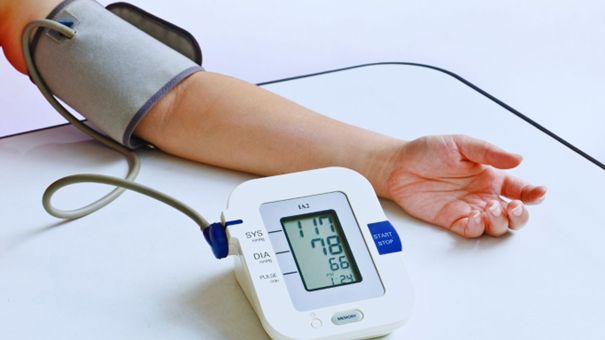today’s fast-paced world, health is a priority, and monitoring your blood pressure at home can play a crucial role in maintaining your well-being. This guide walks you through the importance of home blood pressure monitoring, choosing the right blood pressure monitor, interpreting readings, measuring frequency, ensuring accuracy, and understanding the importance of diagnosing blood pressure. high blood pressure.
What is the reason for monitoring blood pressure at home?

In a time when health matters, monitoring your blood pressure at home is not just a trend but a proactive choice. This practice is of immense importance as it allows individuals to take charge of their cardiovascular well-being. By monitoring blood pressure from the comfort of your own space, you get a consistent and comprehensive view of your heart health. Regular monitoring of your home offers a host of benefits.
- Regular home-monitoring acts as a window into your heart’s behavior over time. This allows you to identify patterns and changes that may indicate potential problems long before they become serious.
- The information gained through home monitoring allows you to make informed decisions about your lifestyle, diet, and medical care. You can proactively adjust your habits based on your blood pressure trends.
- Home monitoring offers unparalleled convenience. You can check your blood pressure at any time without the need for appointments or visits to health facilities.
- Home monitoring allows continuous monitoring of your cardiovascular status. This is especially helpful if you have risk factors such as a family history of high blood pressure or pre-existing health conditions.
- By detecting fluctuations early, you are better equipped to seek timely medical intervention if needed. This preventative approach can reduce the risk of long-term complications.
Which home BP monitor should I buy?

When it comes to choosing a home blood pressure monitor, it is essential to make an informed decision. The market offers a range of options, from upper arm monitors to wrist monitors, each with its own advantages and disadvantages. Opting for a clinically validated device ensures accuracy, a key factor for reliable readings.
Upper arm monitors, due to their location, tend to provide more accurate results. On the other hand, wrist monitors are convenient but can be slightly less accurate. Deciding between the two depends on your priorities, but consulting your healthcare professional is paramount. They can guide you based on your health needs and recommend a monitor that meets your requirements.
Key Features About BP Measurement
- Understanding blood pressure values is essential for assessing cardiovascular health.
- A standard blood pressure measurement consists of two numbers: systolic and diastolic.
- Systolic (higher number) reflects blood pressure as the heart contracts.
- Diastolic (lower number) indicates the pressure during the resting phase of the heart between beats.
- A normal reading is around 120/80 mm Hg.
- Deviations from this range may indicate potential health issues.
- A single high reading should not immediately trigger an alarm; consistency matters.
- Monitoring blood pressure over time helps identify consistent trends and variations.
- Prompt medical attention is advised when readings are consistently abnormal.
How to take BP measurements at home?
The frequency of home blood pressure measurements depends on factors such as your medical condition, risk factors, and medical advice. As a general rule, measuring your blood pressure at least twice a day provides valuable information. Morning and evening readings are ideal, as they capture potential fluctuations.
Consistency is essential. By regularly measuring your blood pressure, you gather a complete set of data that your doctor can analyze. Sharing this data facilitates a deeper understanding of trends in your heart health and guides any necessary interventions or adjustments in your treatment plan.
How can we get an accurate measurement of blood pressure?

Accurate blood pressure readings are the foundation of effective monitoring. Achieving this accuracy requires following a few important steps:
- Preparation: Take a moment to relax before measuring your blood pressure. Rest for about 5 minutes and avoid consuming caffeine, smoking, or vigorous exercise for at least 30 minutes before reading.
- Proper Positioning: Sit comfortably with your back supported and your feet flat on the floor. This position helps keep your blood pressure at a constant level.
- Placement of the cuff: place the cuff at the level of your heart. It is crucial to place it correctly to ensure accurate readings.
- Relaxation: During the measurement, remain still and refrain from talking. Movement or conversation may impact reading accuracy.
- Multiple readings: For the most accurate results, take two to three readings with a minute or two of rest between each. The average of these values provides a reliable representation of your blood pressure.
The importance of diagnosing high blood pressure
Understanding the importance of diagnosing high blood pressure cannot be underestimated. Often referred to as the “silent killer,” hypertension can remain asymptomatic for an extended period of time while silently damaging your arteries, heart, and organs. Untreated, it greatly increases the risk of heart attack, stroke, kidney problems, etc. Diagnosing high blood pressure at an early stage allows for prompt interventions that can prevent or mitigate these serious health consequences. By regularly monitoring your blood pressure at home and promptly addressing any concerning readings, you are taking a proactive step in protecting your overall health.





